POLISH NATIONALISTS TO DIE
Moscow, Soviet Union • March 5, 1940
In a proposal written on this date in 1940 to Soviet dictator Joseph Stalin and other members of the Soviet Politburo, Lavrentiy Beria, who was the unsavory head of the People’s Commissariat for Internal Affairs (NKVD), the Soviet secret police, advocated executing all members of the Polish Officer Corps who had been captured in the Soviet Union’s treacherous invasion of Eastern Poland in September 1939. (In their mutual nonaggression pact of August 1939 Nazi Germany and the Soviet Union had secretly agreed on the terms of a division of their common neighbor prior to Adolf Hitler’s blitzkrieg against Poland on September 1, 1939.) From their area of occupation the Soviets deported upwards of 1.5 million Poles in 1940–1941.
Stalin signed the order to execute 25,700 Polish “nationalists and counterrevolutionaries” kept at camps and prisons in Western Ukraine and Belarus. Their execution was intended to prevent them from organizing any resistance to Soviet rule in their homeland. The victims were murdered in the Katyn Forest near Smolensk in Russia and in sundry Soviet prisons and NKVD-run camps in April and May 1940. Of the total killed, about 8,000 were Polish military officers and another 6,000 were police officers. (Between 250,000 and 454,700 Polish soldiers and policemen are estimated to have been interned in camps by authorities after the Soviet invasion.) The remainder of the Katyn victims were Polish intelligentsia who had been arrested for allegedly being intelligence agents, gendarmes, landowners, saboteurs, factory owners and businessmen, lawyers, officials, and priests. In this manner, and by similar measures the Nazis employed in their (western) half of Poland, the leading elements of Poland’s political, military, cultural, entrepreneurial, and educational classes were effectively eliminated (family members of the executed were deported to labor camps) and the wellspring of potential sources of resistance to the new order in the conquered territories drained.
Months after Hitler had turned on his treaty partner and invaded the Soviet Union (Operation Barbarossa), German occupation forces found some of the mass graves in the Katyn Forest and trumpeted their discovery in their ongoing anti-Bolshevik propaganda, going so far as to invite Allied POW officers as well as forensic experts and their staffs from friendly or occupied countries in Europe to concur with them that the Soviets were behind the massacre of Polish civilians and military and police personnel. The 1943 revelation led to the end of diplomatic relations between Moscow and the London-based Polish government-in-exile. The Soviet Union continued to deny responsibility for the massacres until 1990, when it officially acknowledged and condemned the killings by the NKVD.
Soviet Massacre of Polish Nationals, Katyn, Russia, April–May 1940
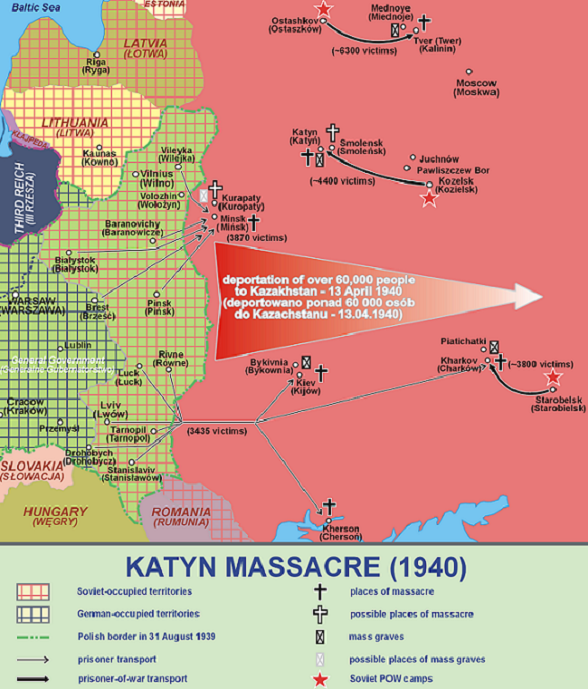 |
Above: Map of sites related to the 1940 Katyn Massacre. The massacre was a mass execution of more than 25,000 Polish nationals in April and May 1940 carried out by the People’s Commissariat for Internal Affairs (NKVD), which had taken custody of Polish prisoners from the Red Army and operated prisoner-of-war camps in the western part of the Soviet Union. The victims were murdered in the Katyn Forest in Russia, in the NKVD-run Tver (Kalinin) and Kharkov (Kharkiv) prisons, and elsewhere. The mass executions are now subsumed under one name, “Katyn Massacre.” Thousands more Polish “bourgeoisie elements” were deported to camps in the East, where they endured forced labor, starvation, and neglect or simply disappeared. The Soviet cleansing of Polish society was based on class-political criteria and differed from that of the Nazis’, whose criteria were primarily racial and religious based.
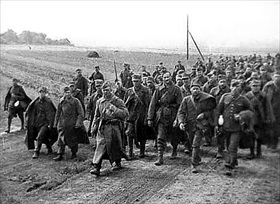 | 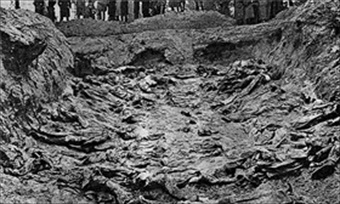 |
Left: Polish POWs captured by the Red Army during the Soviet invasion of Poland in 1939. Between April and May 1940, the NKVD transferred approximately 14,500 Polish military officers from a POW camp in Kozelsk to a forest near Katyn (roughly 12 miles/19 kilometers west of Smolensk, Russia), where they were executed.
![]()
Right: One of the mass graves uncovered by Germans in the Katyn Forest in occupied Russia, 1943. Joseph Goebbels, the Nazi minister of propaganda, used the grim discoveries to drive a wedge between the London-based Polish government-in-exile and the Allies, and reinforce the Nazi line about the danger of Soviet Bolshevism to Western civilization. Competing commissions investigating the massacre—one a Red Cross commission, the other a Soviet one—blamed the other side for the atrocity.
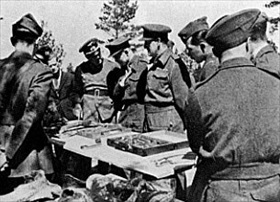 | 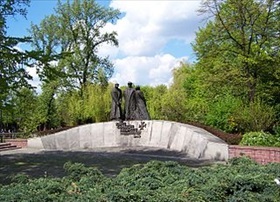 |
Left: In addition to members of the International Katyn Commission, a Red Cross committee staffed by forensic experts drawn mainly from Nazi-occupied Europe, a number of American, Canadian, and British POWs, as shown in this photograph, examined the Katyn remains.
![]()
Right: Monument in Katowice, Poland, memorializing “Katyn, Kharkіv, Miednoye, and other places of murder in the former USSR in 1940.”
Katyn: WWII’s Forgotten Massacre (Account of the Massacre starts 5:45 minutes into video)
![]()

 History buffs, there is good news! The Daily Chronicles of World War II is now available as an ebook for $4.99 on Amazon.com. Containing a year’s worth of dated entries from this website, the ebook brings the story of this tumultuous era to life in a compelling, authoritative, and succinct manner. Featuring inventive navigation aids, the ebook enables readers to instantly move forward or backward by month and date to different dated entries. Simple and elegant! Click
History buffs, there is good news! The Daily Chronicles of World War II is now available as an ebook for $4.99 on Amazon.com. Containing a year’s worth of dated entries from this website, the ebook brings the story of this tumultuous era to life in a compelling, authoritative, and succinct manner. Featuring inventive navigation aids, the ebook enables readers to instantly move forward or backward by month and date to different dated entries. Simple and elegant! Click 











